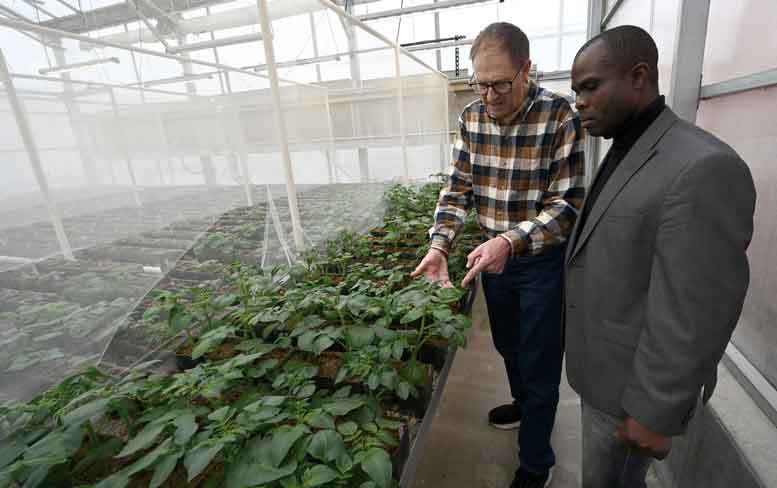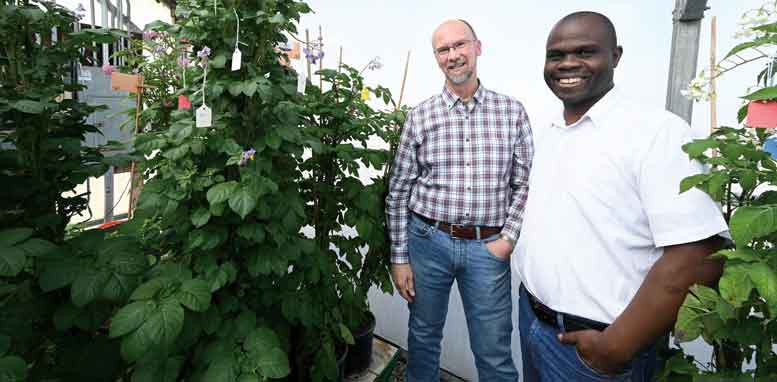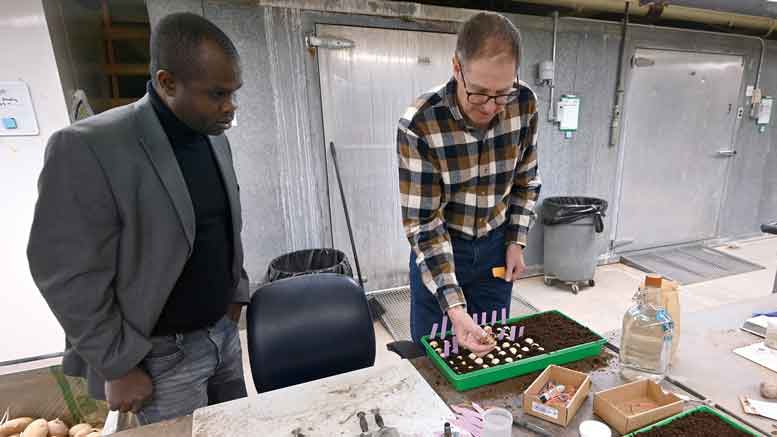|
Click to listen to this article
|
Story and photos by Bill Schaefer
Could a seed potato researcher from Kenya provide key disease-resistant germplasm for the next generation of Idaho potatoes? And in a quid pro quo arrangement, could Idaho researchers provide Kenya with new potato varieties to provide greater yield, nutritional value and profitability to Kenya’s potato industry?
Only time and thousands of potato trials will provide the final answers to both questions. In the meantime, three researchers continue their efforts at the University of Idaho’s Research and Extension Center in Aberdeen, Idaho.
Kenyan potato breeder John Onditi has traveled over 8,000 miles from Mount Elgon, Kenya, to work with USDA-ARS research scientists Rich Novy and Jonathan Whitworth at Aberdeen in a joint effort to develop new potato varieties with genetic resistance to potato cyst nematodes (PCN), late blight, Potato virus Y (PVY) and Potato virus X (PVX).
Onditi is the sole potato breeder in the Kenya Agriculture and Livestock Research Organization, a government agency. He has just completed the first year of a two-year research grant allowing him to work with Novy and Whitworth in Aberdeen. He, his wife and their four children moved to Aberdeen in 2023.
“I have a contract for two years, post-doc contract for two years,” Onditi said. “The title of my project is ‘Breeding Processes of PVY and Potato Cyst Nematode.’ I work in the PVY- and the PCN-resistant breeding program here. My personal objective of joining this is because I enjoy working on PVY and because the virus is one of the major problems in my country. Farmers don’t understand how to eliminate the virus, and I feel like because farmers don’t have a good understanding on how to eliminate the viruses, the cyst nematode, I’ve been feeling that one of the best ways that African farmers can be helped is to give them resistant varieties.”

Exchanging Germplasm
Novy has been a research geneticist for 25 years, and Whitworth has worked for 21 years as a plant pathologist at the Aberdeen facility. Working together, they have taken genetic samples of potato varieties around the world to incorporate in the potato breeding program in Aberdeen.
The majority of potato varieties grown in Kenya are Unica, Dutch Robjn, Shangi and Sherekea.
“The most popular variety is called Shangi. It is a cream flesh, cream skin with pink eyes, slightly oblong,” Onditi said.
“From my perspective as a breeder, it’s always good to bring in a new infusion of diverse material. And in breeding for potato cyst nematode, we have brought in germplasm from South America, Europe and New Zealand, and the reason is the incorporation of potato cyst nematode resistance into the russet market class,” Novy said. “And so that’s where it’s good – for example, with John bringing germplasm and varieties in from his work in Kenya.”
Whitworth sees similar advantages in the cooperative arrangement.
“His help to our program is some access to new germplasm and the ability to get some of our material out in a wider area because we have a pretty diverse germplasm base,” Whitworth said. “We have a lot of resistances that are in there, just to get those out to other parts of the world. The exchange of germplasm is a direct benefit to the potato industry, and it just helps worldwide.”
There are no russet varieties currently grown in Kenya, but Onditi expressed a desire to introduce russet varieties in Kenya because of their large size and nutritional value. The problem, according to Onditi, is acceptance by Kenyan growers of the brown-skinned russet.
“Farmers would need to be educated to understand that russet skin, even if it doesn’t look so cosmetic, what matters most is if you can produce a big potato that can feed a family, can feed your people, it is a good thing so we don’t have to care so much about the skin,” he said.
According to Whitworth, Onditi’s research runs parallel with their PCN and virus research, thereby providing both Kenya and the U.S. with mutual benefits.
“The connection here is because we are a breeding program that is working on PVY resistance and potato cyst nematode resistance, because it’s an issue in both countries, and in the U.S., we have the cyst nematodes quarantined to a very small area and very well controlled,” Whitworth said. “But we still have to develop resistant varieties, so we can exchange germplasm between his program and our program here, and we can help them get resistant varieties, and then he can bring some of those Kenyan varieties over here to increase our germplasm base to make it more diverse.”

Considering Kenyan Conditions
Two key differences between the two countries and their respective potato programs is the length of the growing season and the amount of sunlight plants receive during the growing season.
Kenya is bisected by the equator. As such, it averages 12 hours of sunlight daily year round, and it has two growing seasons annually. The first growing season runs from April planting to August harvest, with the second season planting in October and harvest in January or February.
In Idaho, there is one growing season and the maximum amount of sunlight is over 15 hours at the summer solstice.
In an attempt to acclimate potato plants from Idaho to the Kenyan growing season, Onditi has selected 100 potato hybrids from Aberdeen and sent 200 true potato seeds (TPS) of each variety, a total of 20,000 TPS, to be grown at his research facility in Kenya.
“Because we have a diverse germplasm here, we’ve gone through it and picked out the ones that have the right characteristics for resistance and also have the agronomic attributes that he thinks will do well in Kenya. Then they’ll grow those out and select them and start new breeding lines,” Whitworth said.
“Right now, out of the work we’ve been doing, out of the collaboration, we are going to be sending 100 families of the crosses with virus resistance, potato cyst nematode resistance and also late blight resistance crosses,” Onditi said. “They are going to be grown and selected under Kenyan conditions with the expectation that we are going to get resistant varieties from this material that we collected from a wide variety of potato germplasm from different regions of the world. This is going to be very useful to Kenya.”

